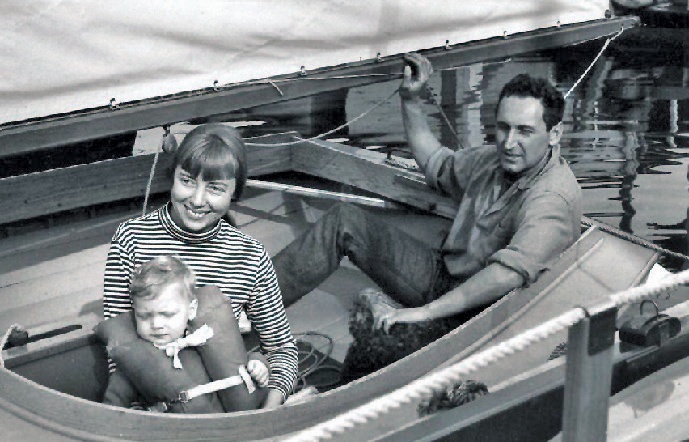Columbia College | Columbia University in the City of New York
Dick Wagner ’54 Takes Hands-on Approach to Maritime History
Walking the shore of Seattle’s Lake Union in the late 1960s, Dick Wagner ’54 and his wife, Colleen, noticed a change on the waterfront. The fiberglass revolution had hit boat building, and longtime makers of classic wooden craft were closing up shop.
COURTESY THE CENTER FOR WOODEN BOATS
Back on their houseboat, with their own collection of a dozen small wooden sailboats tied to the stern, the couple decided to act. They hung a sign, “The Old Boat House,” on the dock, and began renting their little fleet to all comers. With that, a new kind of hands-on maritime museum was born.
“Before the summer was over, three newspapers and three TV stations interviewed me, and everyone and their pet pig knew this was a place to learn about sailing and to have a lot of fun,” Wagner says.
Today, The Center for Wooden Boats (CWB) is an interactive museum and education center on Lake Union. A nonprofit since 1976, it has worked with more than 60 communities around the world to promote the art and history of sailing and of wooden boat building. St. Petersburg, Russia; Alexandria, Va.; Fogo Island, Newfoundland; Provo, Utah; Coos Bay, Ore.; Sausalito, Calif., and Kalispell, Mont., all have similar sailing education centers, started under the tutelage of the Wagners.
“We provide a direct, hands-on educational experience,” Wagner says. “Learning to sail is like learning to ride a bike or learning to drive. It’s not an education by laptop or lectern. You learn naturally, by watching and doing.”
An architect by training, Wagner studied history at the College and credits art and architecture professor George R. Collins for first exposing him to hands-on education. “His assignments were to go around New York, to look at buildings, to talk to architects,” Wagner recalls. “I’d walk up and down the avenues, discovering art, talking with people about buildings, writing architects with questions.”
While at the Yale School of Architecture, where he earned a master’s in 1958, Wagner interned one summer for a Seattle firm. The New Jersey native had never been west of the Delaware River. “I fell in love with Seattle,” he says. After another summer internship, he moved to Lake Union, and fell in love again, with Colleen. Around that same time, Wagner’s work took him to Puget Sound. On the dock he watched a man struggling with the mast of an old wooden sailboat. Wagner offered to help, and in time learned to sail himself. “He was one of these guys who didn’t say much,” Wagner recalls. “He had me watch, then pointed out a thing or two to do. I wish I remembered his name.” The friendship was brief, but Wagner learned much and was soon studying books on sailing and boat building.
After Wagner’s marriage to Colleen, the couple traveled the world together by sea, hitching passage on a Dutch olive oil tanker and Grecian passenger ships, and worked for four months on an archeology dig in Masada, Israel.
On their return in 1968, the Wagners began teaching sailing and renting out wooden boats. They soon saw their future in community-based teaching. Wagner continued contract architect work, but dedicated much of his time to educating locals and tourists about catboats and Marconi rigged sloops.
“More work than you can imagine goes into a wooden boat, a boat that’s seaworthy and beautiful,” Wagner says. “The steaming of wood and making of perfect joints, the bronze fastenings. These aren’t craftsmen cutting pieces of soap, and in the late 1960s it was only being done in parts of Maine and on our little lake in Seattle.”

Colleen and Dick Wagner ’54 in CWB's early days.
COURTESY THE CENTER FOR WOODEN BOATS
The center’s sites — two on Lake Union, one on Camano Island in nearby Puget Sound — receive more than 100,000 visitors a year. CWB is poised to break ground on a fourth site on Lake Union in early 2016, the Wagner Education Center, which will provide learning opportunities for more than 5,000 children annually.
“Dick has this indefatigable imagination but what makes it special is it’s always in service of the community,” says Caren Crandall, CWB’s first assistant director and now a professor at the University of Washington. “Before the center, South Lake Union was a rather stark industrial place, and now it’s home to museums, restaurants, a city park, public water access. In 30-plus years it’s been completely transformed, and Dick’s vision showed people how that was possible.”
At CWB, preschoolers can listen to maritime tales aboard heritage vessels. Elementary school students can build toy boats with hand tools. Middle schoolers and high schoolers can construct replica boats and learn to sail them. There are programs for the physically disabled, including sailing instruction for the wheelchair-bound, the deaf and the blind. Many of CWB’s workshops and programs are focused on disadvantaged and underserved youth who wouldn’t otherwise have access to the waterfront.
“We’re thrilled to see people of all ages learning something,” Wagner says. “It’s changed many lives, and I couldn’t be happier about it.”
Michael R. Shea SOA’10 is a freelance writer based in Ithaca, N.Y. His work regularly appears in Field & Stream and a variety of other outdoor publications. Visit michaelrshea.com or find him @michaelrshea.
Issue Contents
Published three times a year by Columbia College for alumni, students, faculty, parents and friends.
Columbia Alumni Center
622 W. 113th St., MC 4530, 4th Fl.
New York, NY 10025
212-851-7852
cct@columbia.edu
Columbia Alumni Center
622 W. 113th St., MC 4530, 4th Fl.
New York, NY 10025
212-851-7488
ccalumni@columbia.edu

